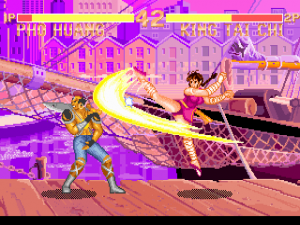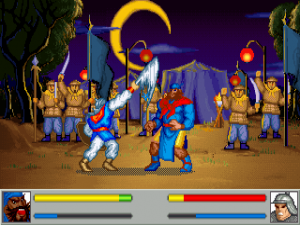 |
|
History
The story of Sango Fighter begin with Super Fighter, a game heavily inspired by Street Fighter II. Super Fighter was created by C&E Inc. a Taiwanese company. Shortly after the release of the game, Jon Cheng, Super Fighter’s lead programmer, was contacted by a shareholder of Panda Entertainment, also from Taiwan. The shareholder who knew Jon Cheng from a colleague, decided to reach out to him when he heard he was planning to leave C&E. After discussing the matter with a few colleagues, Jon Cheng decided to start his own studio and worked by contract for Panda. At the time, they were only four members in our studio: one programmer, one character designer and two artists. Four months later, they formally joined Panda and became shareholders.
The first project of Jon was Sango Fighter. Jon used his experience on Super Fighter as a starting point and improved on the recipe : “I didn’t have a debugger for Super Fighter, since I’d used all the system memory to store the game data. The only debugger was my eyes. I spent nearly four months rewriting the Super Fighter engine with the help of Soft-ICE, which helped to shorten my debugging time. The resulting game, Sango Fighter, was released by Panda Entertainment and quickly became one of the most successful action games on the Taiwanese market.”. But the similitude between Sango Fighter and Super Fighter become apparent to C&E which sued Panda Entertainment, calming that some music and sound in Sango Fighter were identical to the one of Super Fighter. This was indeed true, but as this piece of code was based on a programming book, C&E didn’t have very solid legal ground. This being said, Panda Entertainment decided to accommodate C&E by ceasing all sales of Sango Fighter within Taiwan, so that Jon’s team could concentrate on their next release. Meanwhile, a company Taiwanese called Accend, without the right to the game, contacted Apogee Software, a major shareware retailer of the time, to distribute the game in the U.S. The game was set to be released under the same Violent Vengeance. Accend manage to use the game to rip Apogee Software of their 3D engine before the deal felt through. Accend then decided to illegally sold the game themselves in the USA, thus depriving Panda Entertainment of any royalties.
 |  |  | |||
| Super Fighter DOS – 1993 | Sango Fighter DOS – 1993 | Sango Fighter Super A’Can – 1995 |
So what about the Super A’Can version? Well, during the short time after the release of the PC game and the legal trouble, Panda Entertainment had begun porting the game on the Japanese PC-98 computer and Taiwan’s own Super A’Can game console. Although the console was powerful enough, the Super A’Can port was very inferior to what it could have been. The reason behind it was the complexity of the Super A’Can development kit. Although Jon worked on that version, a different game developer was dedicated to this project. With deadline to respect for the release of the console, which resulted in a inferior port. Before the legal issue, Panda Entertainment had planned to release the game on the Sega Genesis (Mega Drive), thinking it would be the best platform to deliver a quality port. Sadly, this would never become a reality.
The game itself is based on an ancient Chinese history Three Kingdoms. The term Sango (“san guo”) is the romanization of the term Three Kingdoms from Chinese. The game depicts the story of twelve legendary generals fighting to unite a nation torn apart by civil war.
